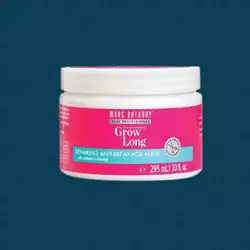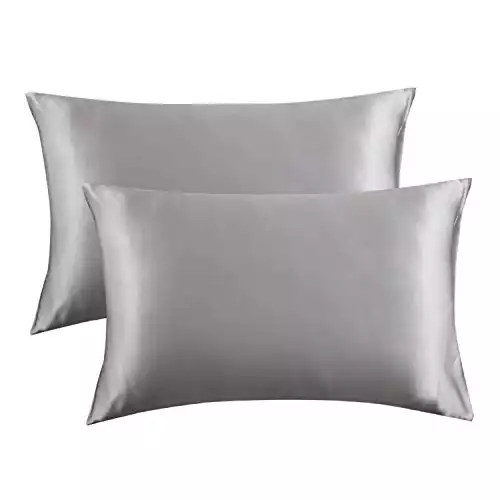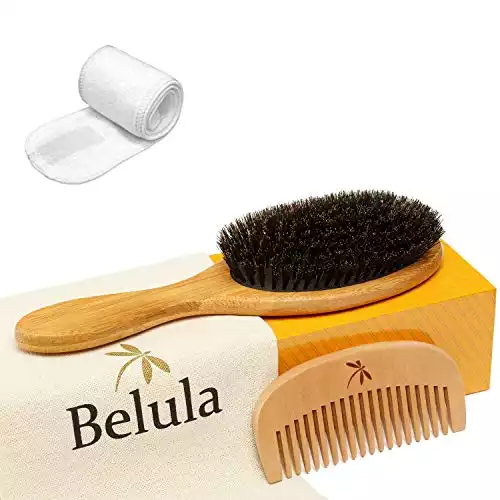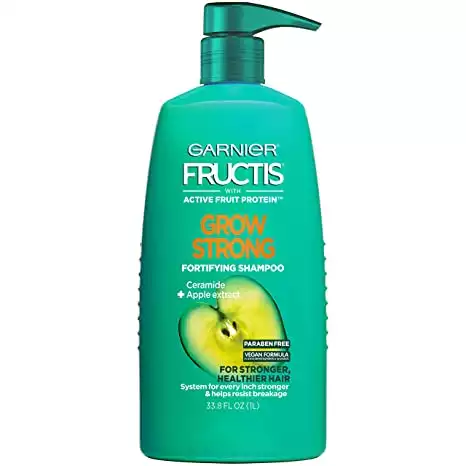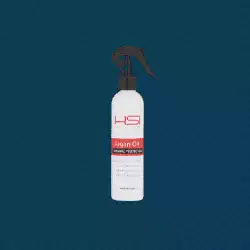Jump to:
What is hair breakage and how can you combat it? Learn what causes hair to break off, how it’s different from hair loss, which types of hair are most susceptible to breakage, and what you can do to reverse it in our guide.
What Is Hair Breakage?
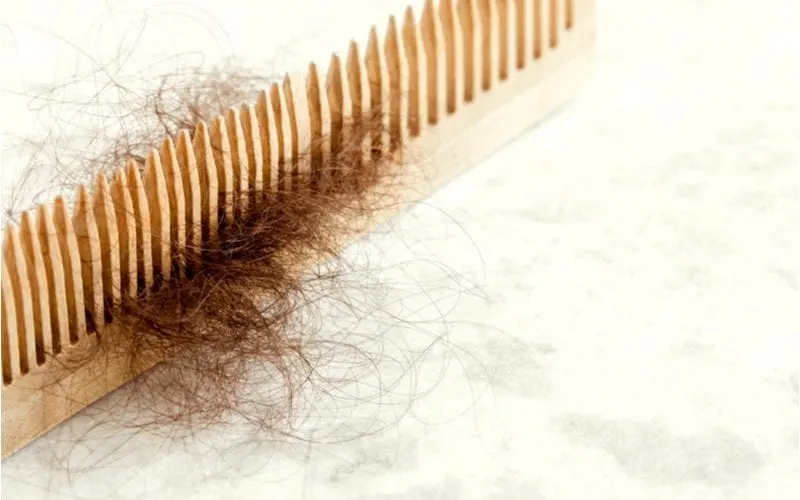
Oksana Mizina/Shutterstock
What is hair breakage and why does it happen? In a nutshell, hair breakage is the arch nemesis of healthy, lush hair. It’s the reason damaged hair seems to grow so slowly, and the cunning adversary behind flyaways and frizz that threaten to wreck even your best hair days.
Hair breakage occurs when the hair shaft breaks off due to weakness or low elasticity. The result is shorter, uneven strands, split ends, flyaways, slow-growing hair, and increased knots and tangles.
Breakage can occur for a variety of reasons. Some hair types are more susceptible to it due to the internal structure of the hair. Long-term damage to your locks can also result in hair breakage.
That’s where most of us run into problems.
Thankfully, hair breakage is easy to spot and there are a variety of ways to treat it. We’re going to outline the things that lead to breakage, how to determine if it’s happening to your hair, and how to differentiate it from thinning and hair loss.
We’ll also share some of the best products we’ve found to stop breakage in its tracks and reverse its effects on your hair. Let’s get started!
What Causes Hair Breakage?

Yomogi1/Shutterstock
We all want healthy hair that is strong, shiny, and soft. Unfortunately, the things we put our hair through on a daily basis can undermine our efforts and damage our locks to the point of hair breakage.
But damage isn’t the only thing that causes hair breakage. The texture and natural color of your hair is a major factor in how susceptible it is to breakage.
Fine or naturally blonde hair has the strongest tendency to break off. This is because fine and blonde hair lacks the medulla, the innermost structure of the hair that lends coarser hair its strength.
Medium hair is less prone to breakage, and coarse hair is the most resistant to it. If the hair shaft is weak for any reason – whether it’s the hair’s fineness, a nutrient-poor diet, or everyday hair damage – breakage becomes a concern.
A chain is only as strong as its weakest link. So if there’s any segment of your hair shaft that is weakened, the slightest pressure or stress on it will result in the hair breaking off at the weakest point.
Here are some of the most common causes of hair breakage:
- Chemical processing (colors, perms, straightening treatments, etc.)
- Exposure to harsh elements (UV rays, wind, etc.)
- Heat damage from hot tools and blow drying
- Rough brushing, shampooing, and styling
- Going too long between trims
- Fine or naturally blonde hair
- Chronic dryness
- Over-washing
- Poor diet
While hair breakage is annoying, it’s not always immediately apparent. But don’t worry — we’ll show you how to spot it before it does any real damage.
Signs of Hair Breakage
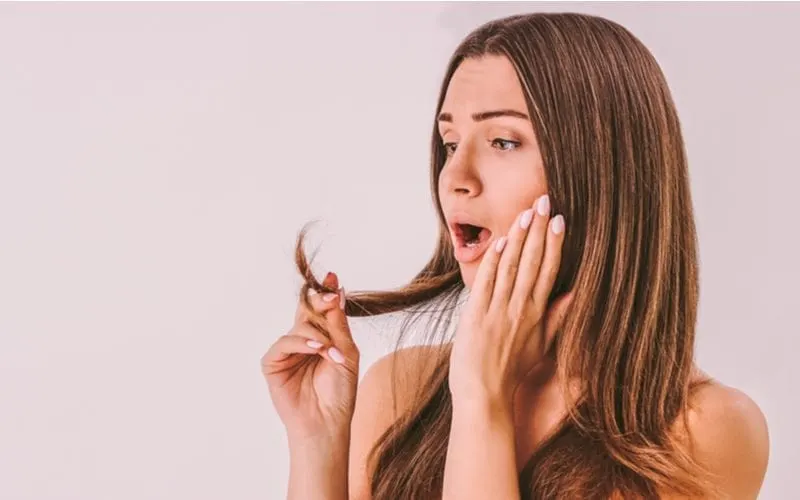
Anna Tryhub/Shutterstock
How can you tell if your hair is suffering from breakage? It’s pretty easy to identify when your hair is weakened to the point of breaking off. Here’s what you’ll notice:
Finding Bits and Pieces of Hair
If you’re seeing small bits and pieces – not full strands – of your hair lying on the ground after brushing or running your fingers through it, it’s a sure sign that you’re experiencing breakage. The size of the pieces you’ll find depend on where your hair is breaking off along the shaft.
If it’s breaking off at the tips, you might only see tiny segments of hair broken off. If it’s breaking off higher up the shaft, you might see strands that are nearly the length of your hair.
More Flyaways
Hair breakage results in more flyaways because many of the strands are breaking off at different points along the shaft. When you have lots of hairs at different lengths, the shortest hairs don’t easily fall in line, instead deciding to do their own thing.
Hair that has been broken off instead of being cut with sharp shears is weakened and jagged at the break point. This results in wispy flyaways that don’t want to lie down and cooperate, no matter what products or styling tools you use.
Increased Knots and Tangles
Broken hair isn’t cleanly cut off, so the jagged end where the shaft separates makes it prone to knotting and tangles. The rough, broken end of the hair strand rubs against and catches on other hairs, forming gnarly tangles that are hard to brush or comb out.
The worst part is that trying to tackle those tangles with the wrong brush or overly rough brushing can result in even more breakage. It’s a vicious cycle.
Split Ends
Take a look at the ends of your hair. If you’re seeing split ends, there’s a good chance you’re also experiencing hair breakage. When the ends of your hair split due to damage or weakness, the problem only continues to get worse if you don’t trim them off.
Splits can travel up the length of your hair shaft, causing breaks to occur high up on the strand. Hair that is damaged enough to have lots of split ends is damaged enough to break off.
The best way to deal with split ends and prevent breakage is getting regular trims. When you cut the strand above a split end, you prevent the split from traveling up the shaft.
Slow Growth
Hair that seems to grow very slowly can be a sign of breakage. Human hair usually grows about half an inch each month. If you’re trying to grow your hair out and are frustrated with how long it’s taking, breakage could be the culprit.
Breakage doesn’t have anything to do with how fast your hair grows, but it will make you think your hair is growing slowly. When your hair’s new growth is constantly breaking off, your hair appears to stay at the same length (or get shorter) when you’re trying to grow it out.
Hair Breakage vs Hair Loss
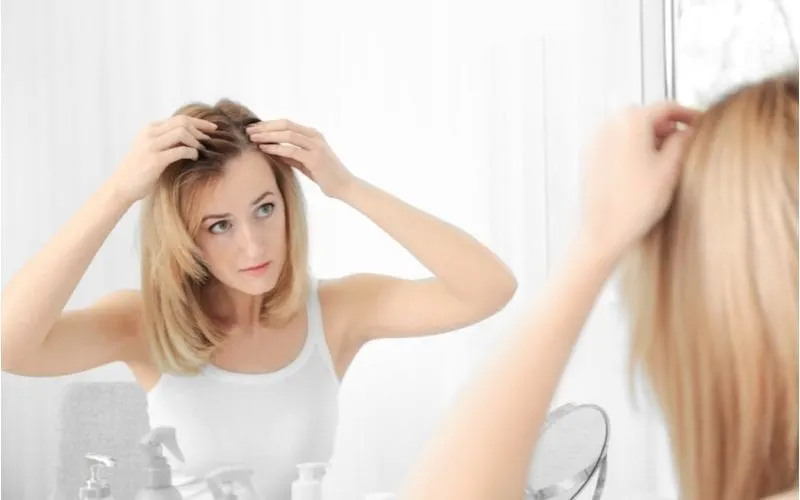
Africa Studio/Shutterstock
It’s easy to confuse hair breakage with hair loss or thinning. But you can tell the two issues apart by looking at the hairs or pieces that come out after brushing or styling.
With hair breakage, you’ll notice bits and pieces of broken hairs lying around after you’ve brushed or styled your hair. Some will be shorter or longer than others because the hairs are breaking off at different points along the shaft.
You won’t see many full strands, or strands with the little white bulb on the root end, lying around. With hair loss or thinning, you will notice full strands falling out, and they’ll all be roughly the same length.
Sometimes, you’ll notice these strands coming out even if you haven’t been brushing or styling your hair. Remember: It’s completely normal to shed 50-100 hairs a day. If you’re losing more than this each day, talk to your doctor or dermatologist about it.
If you’re experiencing hair loss or thinning instead of breakage, take a look at our guide covering the products that can help treat hair loss: 5 Hair Loss Products Proven to Work.
5 Products That Stop Hair Breakage
Once you’ve confirmed that you’re experiencing breakage instead of shedding or hair loss, you need to take action. It’s possible to stop hair breakage by correcting the issues that are causing it in the first place.
You can start by being as gentle as possible with your hair in its weakened state. That means no more rough brushing, brushing wet hair, sleeping on a cotton pillowcase, or cranking up the heat on your flat iron.
These steps can help prevent future breakage, but if you want to speed up the recovery process, you need to enlist the help of products. Here are our favorite breakage-busting products.
1. Strengthening Hair Mask
- Sulfate-free.
- Inexpensive product.
- Hydrates, controls frizz, and nourishes hair.
- Long ingredient label with synthetic ingredients.
- Not ideal for thin hair.
Our favorite product to prevent breakage and encourage hair to grow longer and stronger is the Marc Anthony Grow Long Hair Mask. This nourishing and strengthening mask corrects damage by enriching strands with keratin protein, avocado oil, argan oil, and ginseng.
The protein coats strands to strengthen and fill in any gaps in the shaft. The nourishing oils and natural extracts make your hair feel incredibly soft, but don’t let that fool you.
The end result is ultra-strong hair that resists breakage while maintaining the right moisture balance. It won’t actually make your hair grow faster, but if breakage is preventing you from reaching new lengths, this hair mask is a miracle worker.
2. Satin Pillowcase
A good satin or silk pillowcase is one of the best products to prevent hair breakage. Our top recommendation is the Bedsure Satin Pillowcase for Hair and Skin. It comes in a 2-pack and is super affordable.
More than 168,900+ positive reviews can’t be wrong! I actually sleep on this pillowcase every night to prevent breakage. Unlike cotton pillowcases, the satin material allows your hair to easily glide and slip against it so there are no snags to break the hair off.
Plus, it couldn’t be easier – just pop your favorite pillows into these satin pillowcases and you’re one step closer to healthy, strong hair.
3. 100% Boar Bristle Brush
Boar bristle brushes that are designed for fine or thin hair are perfect for preventing breakage. The Belula 100% Boar Bristle Hair Brush is the top pick in this category.
Boasting more than 4,200 reviews and an average 4.5 star rating, users absolutely love this boar bristle brush. It prevents breakage thanks to the soft-yet-stiff boar bristles that gently glide through hair without snagging.
It removes tangles easily, leaves hair soft and shiny, and won’t force bristles through hair to the point of breakage like other brushes can.
The stiff bristles also massage your scalp for optimal blood flow, which can lead to increased growth and hair health. It comes with some bonus freebies, too!
Read Next: Best Hair Brushes
4. Strengthening and Nourishing Shampoo
- Great bang for the buck
- Rich in vitamins, plant extract, and proteins
- Gigantic bottle
- Thousands of positive user reviews
- Pump bottle leaves product at the bottom
- Not sulfate free
- Has a hint of chemical smell (that goes away)
If your hair is breaking off due to damage or weakness, we recommend giving Garnier Fructis Grow Strong Shampoo a try. Sure, it’s a drugstore brand and costs less than $6, but it gives results that rival professional products that cost 5 times as much.
This shampoo is formulated with hair-strengthening proteins and ceramides that work to “rebuild” each hair strand for maximum strength and durability. This results in less breakage when you go about your normal hair care routine (brushing, styling, cleansing, etc.).
There are also nourishing vitamins, minerals, and plant extracts in it that moisturize and repair your hair to help it resist breakage. If you’re experiencing any amount of breakage, you need to be using a strengthening shampoo like this one.
5. HSI Professional Argan Oil Heat Protector
Heat damage is one of the sneaky culprits of hair breakage, and thankfully, it’s very easy to prevent. All you need is a high-quality heat protectant like HSI Professional Argan Oil Heat Protector.
This is the top-rated heat protectant on Amazon because it protects hair from temperatures up to 450 degrees (the max heat for most hot tools), nourishes and moisturizes hair to prevent dryness and brittleness, and prevents breakage that occurs due to heat damage.
If heat damage is partially to blame for your hair breakage, you will notice less frizz, fewer flyaways, and hair that appears to grow faster when you start using this heat protectant.
You’ll also see a natural shine and softer texture to the hair. More than 31,700+ reviewers say it’s a 4.4 star product. We’d rate it 5 stars.
So, What Is Hair Breakage?
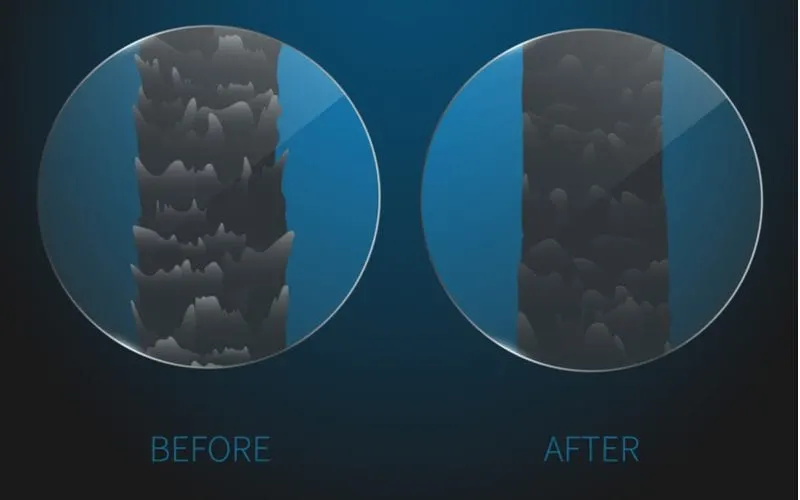
Art4stock/Shutterstock
Are you ready to break up with hair breakage? It’s easy when you have a plan. Here’s what your next steps should be.
- Determine how you’re damaging your hair to the point of breakage – heat damage, exposure to elements, rough handling, chemical processing, etc.
- Find ways to reduce the stress and strain you put on your hair (switching brushes, reducing heat styling, avoiding over-processing, etc.) to reduce breakage
- Try the recommended products above to further prevent breakage (strengthening hair mask and shampoo, boar bristle brush, satin pillowcase, and heat protectant)
Once you’ve pinpointed the causes of hair breakage, you can easily make changes in your hair care routine to avoid them.
If you can’t completely avoid something damaging, such as getting your hair colored regularly or heat styling, making sure your hair is as nourished, moisturized, and strong as possible will help it resist breakage better.
Hair breakage is one of the most common issues we face with longer hair, but it doesn’t have to ruin your look. By taking action once you notice breakage beginning, you can stop it in its tracks and prevent future breakage by using the right products and hair care techniques.

